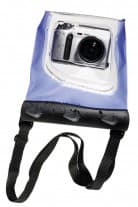Whatever climate you’re shooting in, make sure your equipment will operate within the temperatures that you anticipate.

From summer holidays sepnt lounging on a beach to a once-in-a-lifetime trip the frozen Arctic, extreme climates can present a serious challenge to the health of your camera equipment.
In the worst cases they could even cause your equipment to fail. So, if you want to keep your camera equipement safe, read on and follow our advice.
Hot Climates – sand hazards
Sand is one of the biggest problems for a camera to deal with. It can get into every nook and cranny and will bring a camera to a halt in no time at all.
This isn’t just a point of concern should you accidentally drop a camera into sand; the biggest problem is that it’s usually blown into the lens and body by the wind. This will damage the fine mechanism and movement of a camera quickly and is almost always irreparable.
Even in cases where a repair is possible, charges will generally be higher than buying a new camera altogether. A clear plastic bag with a hole cut for the lens is a simple solution for short-term situations, but if you are planning on spending a significant amount of time in sandy locations, one option is to use a proper underwater housing or bag.
These don’t always have to be expensive and if you weigh it up against the cost of replacing your camera, they are often the best choice.
Don’t let your camera overheat
Viewing your images on LCD screens can be a big problem in bright conditions. You normally have options to adjust the brightness of the LCD screen, but in certain situations even these controls will fall insufficient.
An LCD hood is a useful tool under these circumstances and has the additional benefit of protecting your screen from marks and scratches. The electronics of a camera are designed to work at their optimum at a set temperature. High temperatures can reduce the battery life and eventually start to affect the electronics.
Stuck in a bag, cameras will reach higher temperatures as the bag absorbs the heat. You may want to consider keeping your camera in a cool bag. You can buy bags dedicated specifically to photographic equipment, but a standard plastic cool bag should suffice too.
Usually in these climates, locals avoid going out in the midday sun, and it makes sense that you do likewise. Shooting in the mornings and evenings will avoid being caught in the midday sun and will provide a better light to work with.
Making sure that you’re drinking enough water, taking salt tablets, using sunscreen and wearing a hat to protect you from the sun are vital. Everything else becomes a side issue if you are not fit to travel.
Cold Climates – Beware of Frozen Batteries
 In very cold conditions, the biggest risk is battery failure. Take several batteries with you and keep the spares in your pocket where your body heat will keep them warm. If the one in the camera fails due to the cold, swap it for one from your pocket.
In very cold conditions, the biggest risk is battery failure. Take several batteries with you and keep the spares in your pocket where your body heat will keep them warm. If the one in the camera fails due to the cold, swap it for one from your pocket.
Some can be fitted with battery grips which take AA batteries, some of which can withstand extreme temperatures. Energiser Ultimate Lithium batteries for example, boast a working temperature range of -40°C to +60°C.
Another potential pproblem is the risk of your skin sticking to metal, such as your tripod. Some tripods come with foam leg covers to solve this problem and you can also buy them.
Wearing gloves will solve this problem though they can make camera handling difficult. There are now gloves specifically made for using with cameras, enabling you to operate buttons without needing to remove them first.
Moisture and Humidity
A common problem in tropical countries is condensation forming on the lens. In most cases this will disappear within a couple of minutes but if you try to use a lens before it has, it may result in poor image quality and, more likely than not, return to the surface again.
In some instances, extreme condensation can show as water droplets inside the lens. Dry the outside of your camera as quickly as possible, and, if you have access to an airing cupboard, leave your camera there to help evaporate any residual condensation.
Sea salt can also be a problem anywhere near the coast, especially if you are photographing on the sea itself, so having a cleaning kit for the camera lens and body will ensure that salt doesn’t cause problems.
Climate control
Whatever climate you’re shooting in, make sure your equipment will operate within the temperatures that you anticipate, particularly your batteries and memory cards.
Manufacturers usually state in their manuals the operational limits of their products, and most necessary alternatives, specifically designed to be used in extreme conditions now exist.
Media Cards
Most standard media cards are designed to work in the normal range of temperatures, but they aren’t guaranteed to work in extreme heat or cold.
If you’re going somewhere very hot, or very cold, it’s well worth investing in a few cards designed – and more importantly, guaranteed – to work in such conditions.
In addition to boasting super-fast write speeds, the Sandisk Extreme IV range of cards, for example, are water-resistant and have a stated operating temperature range of -25°C to +85°C. They’re available in capacities up to 8GB
Protect and Serve
 If you are planning on frequently using your DSLR in wet or dirty conditions it may be worth investing in a protective housing. These range from reinforced plastic bags, such as the Aquapac (www.aquapac.com), which comes in various sizes, to hard plastic shells tailor made to fit specific models, and primarily designed for underwater photography.
If you are planning on frequently using your DSLR in wet or dirty conditions it may be worth investing in a protective housing. These range from reinforced plastic bags, such as the Aquapac (www.aquapac.com), which comes in various sizes, to hard plastic shells tailor made to fit specific models, and primarily designed for underwater photography.
Alternatively, if you don’t want to risk your expensive DSLR consider leaving that at home, or at your hotel, and taking a compact instead.
There’s a small Aquapac designed for compacts, or you could invest in a weatherproof digital compact.
There are several on the market that would be better able to withstand the effects of rain and such, and a couple that are even waterproof but make sure you are aware of the limitations of the camera and that you don’t exceed them.







